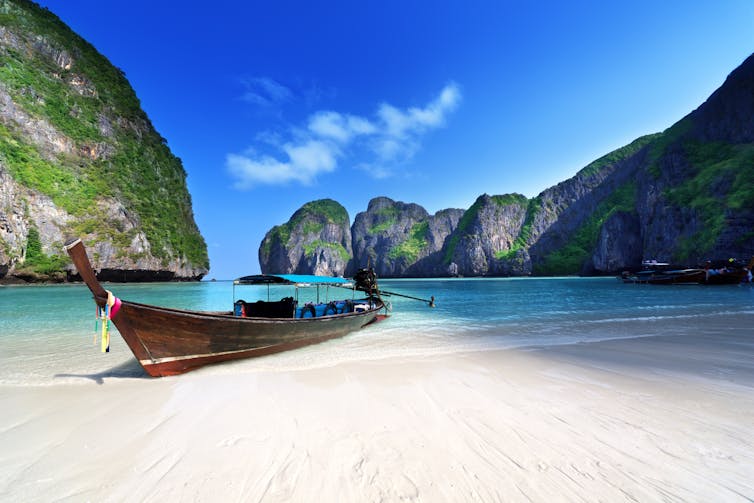Could VR lead to more environmentally-friendly "travel"?
Special to The Weather Network
Monday, October 15, 2018, 1:59 PM - Tourism is often about seeking deeper emotional and personal connections with the world around us. It’s a quintessential part of the “experience economy”, creating memories that can be recalled, re-lived and re-shared for a lifetime.
But not all travel experiences take place in the real world. With the evolution of virtual reality (VR) technology, tourism is increasingly a mash-up of physical and virtual worlds. VR can even remove the need to travel entirely.
Excessive tourism, or over-tourism, in popular destinations can degrade heritage sites, the quality of life of host communities, and the experience of visitors. Virtual reality not only offers alternative forms of access to threatened locations, it also recreates historical experiences and provides virtual access to remote locations you might not make it to otherwise.

Up to 6,000 people were visiting Maya Bay every day before it was closed to tourists. Shutterstock
EVOKING A SENSE OF 'BEING THERE'
Our brains seem to have an inbuilt VR-like mechanism that enables us to live imagined experiences. Much of our waking life is spent thinking about either the past (retrospection) or the future (prospection). This is known as mind wandering.
During these events we’re not paying attention to the current world around us. Instead, we’re recalling memories, or creating and processing imagined futures.
When we’re engaged in mind wandering, our brains process and appraise mental images via the same neural pathways they use to receive stimuli from the real world. So, the imagined past or future can evoke emotions and feelings similar to how we react to everyday life.
VR can elicit these same feelings. Virtual worlds use sensory stimulation and vivid imagery to generate authentic experiences. Immersion in these environments can lead to a deeper understanding of a place or event than simply reading about it or looking at pictures.
There is evidence virtual reality can create absorption, or a state of attention, leading to a sense of “presence” or “being there”. After a tourism VR experience of the Great Barrier Reef, for example, participants reported experiencing a sense of relaxation, similar to that gained from travel in real life.
CHOOSING A DESTINATION
Immersive videos of Australian holiday destinations created by Tourism Australia have been viewed more than 10.5 million times over the past two years. Research conducted by Tourism Australia shows that almost 20% of consumers have used VR to choose a holiday destination, while about 25% plan to use VR to choose a future destination. There is evidence VR can sometimes surpass reality, potentially leading the participant to choose an alternate destination.
SUSTAINABILITY
In March, Thai authorities closed sections of the famous Maya Bay (which featured in Hollywood movie The Beach) because over-tourism threatened coral reefs. VR could offer experiences of locations like this without impacting the natural environment. It could also help support capacity management at “bucket list” destinations, such as Machu Picchu. But if VR is too effective at reducing visitation, alternate forms of income for local people need to be developed to support economic viability.
HISTORICAL RECREATIONS
In 2018, the Australian War Memorial brought the Battle of Hamel to virtual life using 3D and 360 degree video. Designers of the A$100 million Sir John Monash Centre in Villers-Bretonneux, France used immersive video, interactive touch screens and historical relics to recreate the soldiers’ experience on the Western Front during WWI. Similar work is being completed in regional Australia to recreate life on a US Airbase on “the Brisbane Line” – Australia’s controversial last point of defence in WWII.
ACCESS TO REMOTE AREAS
Wildlife watching can elicit feelings of empathy, surprise, novelty, even fear. It can also generate excitement, stimulation, entertainment and learning. But government regulation, cost, remoteness and seasonality of migratory patterns may limit opportunities for people to encounter some of the awe-inspiring creatures on our planet. Virtual immersion can offer alternatives that support conservation goals and provide transformative visitor experiences.
ENHANCING HEALTH AND WELL-BEING
VR tourism could also help to increase health and well-being. Long working hours can lead to anxiety and depression. Research demonstrates immersion in the outdoors encourages relaxation, rejuvenation, expectation, surprise,
New possibilities for VR applications – both practical and pleasurable – are emerging as the technology evolves. And as travellers seek new and novel experiences, combining virtual with real world experiences may become a common feature of tourism in the future.![]()
Vikki Schaffer, Program Co-ordinator and Lecturer, Tourism, Leisure and Event Management, University of the Sunshine Coast; Alexandra Bec, Postdoctoral research fellow, University of the Sunshine Coast; Brent D. Moyle, Associate Dean (Research), Faculty of Arts Business and Law / A/Professor of Tourism, USC Business, University of the Sunshine Coast, and Noel Scott, Professor at the Institute of Tourism, Griffith University
This article is republished from The Conversation under a Creative Commons license. Read the original article.




